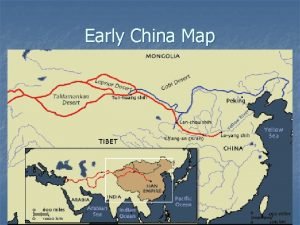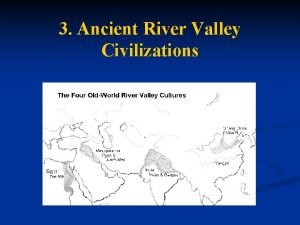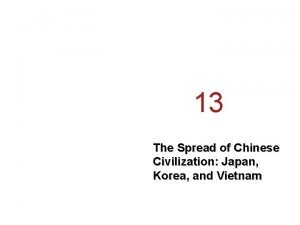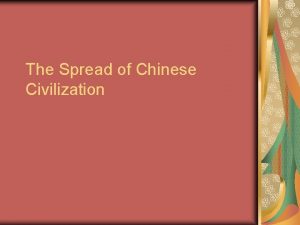The Spread of Chinese Civilization Stearns Chapter 13









- Slides: 9

The Spread of Chinese Civilization Stearns Chapter 13

China leads, others follow • When forming their own civilization, Japan looked towards China for examples to emulate • Outside nomadic peoples were also influenced by the Chinese • Vietnam & Korea had long been influenced by China • All blended Chinese ideas with their own indigenous cultures to create their own blended civilization • For all three, Buddhism would be a key force in the spreading of Chinese Civilization


Japan • Due to its geography, Japan remained isolated for much of its history. • By 200 CE, extensive agriculture had developed • Early regional tribal political organizations • Shintoism (Japanese religion) led to the religious worship of political leaders and other spirits of nature. • A national cultural unity-along with much greater contact with China-would begin to emerge by the 6 th century.

Japanese Sinification • In 522, Buddhist missionaries from China arrived in Japan • Shinto beliefs were never replaced, but rather blended with the new religion • Later, Chinese-influenced bureaucratic and legal reforms were introduced • Taika Reforms (645) modeled on the success of the Tang Dynasty • While much was adopted, Confucianism & the notion of the scholar-gentry was rejected • In Japan, it was more who you were rather than what you knew. • The Aristocracy was much stronger in Imperial Japan than in Tang or Song China

Rise of the Military Elite • With the abandonment of a Chinese-style central government, Japan would ultimately devolve into hundreds of competing states controlled by local warlords • Japanese Feudalism • Shogun • Daimyo • Samurai • Peasants • Due to its decentralization and the prominence of the military in Japanese life, Japan would be bathed in warfare for hundreds of years.

Korea • Korea’s proximity to China led to much greater influence over a longer period of time than Japan • There still, however, was a retention of a separate cultural and political identity • Like in Japan, Buddhism was a conduit for Sinification in Korea • Once dominated by the Han, Korea would become a vassal state under the Silla to the Tang • Great influence would come from China, but like Japan, the power of aristocratic families would prevent Korea from becoming a Chinese-style state.

Vietnam • Referred to by the Chinese as ‘southern barbarians” • Relatively far from the cultural centers of China with their own distinct culture • Language, village autonomy, status of women • Raided by the Qin in the 220’s BCE beginning a trading relationship • The Han secured tribute from and then conquered Vietnam bringing great influence from China • Aristocratic revolts and a resistance of Chinese culture by the peasantry would keep Vietnam from being absorbed into China proper. • By 939, Vietnam was independent

Sinification of Japan, Korea and Vietnam • All were suitable for sedentary agriculture and the development of civilization • Elements of Chinese culture would spread • Writing, bureaucratic organization, religion, art • These imports were all (except for Buddhism) monopolized by the elites. • Korea the most influenced, then Vietnam, then Japan • Little awareness of large world currents than other major civilizations

















